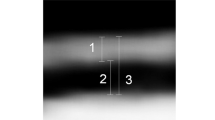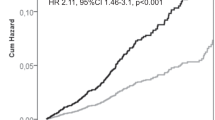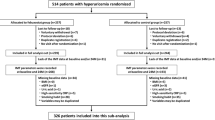Abstract
Carotid intima–media thickness (IMT) assessed by ultrasonography is regarded as an early predictor of general arteriosclerosis in patients with essential hypertension. However, the methods of measuring IMT have not been globally standardized, and it remains unclear whether conventional measurement of IMT represents the prevalence of hypertensive target organ damage. In this study, we verified the association between several commonly used carotid ultrasonographical parameters and the severity of hypertensive target organ damage (retinal arteriosclerosis, microalbuminuria, left ventricular hypertrophy (LVH)). Carotid ultrasonography, echocardiography, urinalysis, and funduscopy were performed in 184 patients (64 ± 12 years, 96 males and 88 females) with various stages of essential hypertension. Carotid arteriosclerosis was assessed using four methodologically different methods: conventional-IMT, maximum-IMT (Max-IMT), Mean-IMT, and Plaque Score (the sum of all plaque thicknesses). Age and all carotid ultrasonographical parameters were significantly associated with albuminuria, retinal arteriosclerosis, and left ventricular mass index. High-sensitivity CRP was significantly correlated with retinopathy and LVH. Carotid parameters in patients with histories of cardiovascular events were significantly greater in those without events. Among all carotid parameters, Max-IMT showed the highest correlation coefficient of the severity of target organ damage, and showed significant association with CRP. Stepwise regression analysis revealed that Max-IMT was the independent factor for predicting target organ damage. Max-IMT is suggested to be the most reliable and simplest parameter for predicting hypertensive target organ damage including microangiopathy in patients with essential hypertension.
This is a preview of subscription content, access via your institution
Access options
Subscribe to this journal
Receive 12 digital issues and online access to articles
$119.00 per year
only $9.92 per issue
Buy this article
- Purchase on Springer Link
- Instant access to full article PDF
Prices may be subject to local taxes which are calculated during checkout



Similar content being viewed by others
References
Pignoli P et al. Intimal plus medial thickness of the arterial wall: a direct measurement with ultrasound imaging. Circulation 1986; 74: 1399–1406.
Bigazzi R et al. Increased thickness of the carotid artery in patients with essential hypertension and microalbuminuria. J Hum Hypertens 1995; 9: 827–833.
Cuspidi C et al. Left ventricular concentric remodelling and carotid structural changes in essential hypertension. J Hypertens 1996; 14: 1441–1446.
Bots ML et al. Common carotid intima–media thickness and risk of stroke and myocardial infarction: the Rotterdam Study. Circulation 1997; 96: 1432–1437.
Vaudo G et al. Arterial wall thickening at different sites and its association with left ventricular hypertrophy in newly diagnosed essential hypertension. Am J Hypertens 2000; 13: 324–331.
Pedrinelli R et al. Dissociation between microalbuminuria and common carotid thickness in essential hypertensive men. J Hum Hypertens 2000; 14: 831–835.
Mykkanen L et al. Microalbuminuria and carotid artery intima–media thickness in nondiabetic and NIDDM subjects. The Insulin Resistance Atherosclerosis Study (IRAS). Stroke 1997; 28: 1710–1716.
Mannami T et al. Prevalence of asymptomatic carotid atherosclerotic lesions detected by high-resolution ultrasonography and its relation to cardiovascular risk factors in the general population of a Japanese city: the Suita study. Stroke 1997; 28: 518–525.
Handa N et al. Ultrasonic evaluation of early carotid atherosclerosis. Stroke 1990; 21: 1567–1572.
Khattar RS et al. Value of ambulatory intra-arterial blood pressure monitoring in the long-term prediction of left ventricular hypertrophy and carotid atherosclerosis in essential hypertension. J Hum Hypertens 1999; 13: 111–116.
Handa N et al. Ischemic stroke events and carotid atherosclerosis. Results of the Osaka Follow-up Study for Ultrasonographic Assessment of Carotid Atherosclerosis (the OSACA Study). Stroke 1995; 26: 1781–1786.
Pontremoli R et al. Prevalence and clinical correlates of microalbuminuria in essential hypertension: the MAGIC Study. Microalbuminuria: A Genoa Investigation on Complications. Hypertension 1997; 30: 1135–1143.
Pedrinelli R et al. Microalbuminuria, an integrated marker of cardiovascular risk in essential hypertension. J Hum Hypertens 2002; 16: 79–89.
Ferrieres J et al. Carotid intima–media thickness and coronary heart disease risk factors in a low-risk population. J Hypertens 1999; 17: 743–748.
Zanchetti A et al. Risk factors associated with alterations in carotid intima–media thickness in hypertension: baseline data from the European Lacidipine Study on Atherosclerosis. J Hypertens 1998; 16: 949–961.
Tang R et al. Baseline reproducibility of B-mode ultrasonic measurement of carotid artery intima-media thickness: the European Lacidipine Study on Atherosclerosis (ELSA). J Hypertens 2000; 18: 197–201.
Salonen JT, Salonen R . Ultrasonographically assessed carotid morphology and the risk of coronary heart disease. Arterioscler Thromb 1991; 11: 1245–1249.
Adams MR et al. Carotid intima–media thickness is only weakly correlated with the extent and severity of coronary artery disease. Circulation 1995; 92: 2127–2134.
Jager A et al. C-reactive protein and soluble vascular cell adhesion molecule-1 are associated with elevated urinary albumin excretion but do not explain its link with cardiovascular risk. Arterioscler Thromb Vasc Biol 2002; 22: 593–598.
Ross R . Atherosclerosis—an inflammatory disease. N Engl J Med 1999; 340: 115–126.
Kamide K et al. Influence of aging on progression of cardiovascular complications associated with insulin resistance in patients with essential hypertension. Hypertens Res 1997; 20: 127–132.
Ekstrand AV, Groop PH, Gronhagen-Riska C . Insulin resistance precedes microalbuminuria in patients with insulin-dependent diabetes mellitus. Nephrol Dial Transplant 1998; 13: 3079–3083.
Chaturvedi N et al. Markers of insulin resistance are strong risk factors for retinopathy incidence in type 1 diabetes. Diabetes Care 2001; 24: 284–289.
Author information
Authors and Affiliations
Corresponding author
Rights and permissions
About this article
Cite this article
Takiuchi, S., Kamide, K., Miwa, Y. et al. Diagnostic value of carotid intima–media thickness and plaque score for predicting target organ damage in patients with essential hypertension. J Hum Hypertens 18, 17–23 (2004). https://doi.org/10.1038/sj.jhh.1001628
Received:
Revised:
Accepted:
Published:
Issue Date:
DOI: https://doi.org/10.1038/sj.jhh.1001628
Keywords
This article is cited by
-
Alcohol drinking patterns have a positive association with cognitive function among older people: a cross-sectional study
BMC Geriatrics (2022)
-
Cardio-ankle vascular index is more closely associated than brachial-ankle pulse wave velocity with arterial damage and risk of cardiovascular disease in patients with diabetes
BMC Cardiovascular Disorders (2022)
-
Comprehensive assessment of systemic arteriosclerosis in relation to the ocular resistive index in acute coronary syndrome patients
Scientific Reports (2022)
-
Aortic arch calcification with pericardial fat mass detected on a single chest X-ray image is closely associated with the predictive variables of future cardiovascular disease
Heart and Vessels (2022)
-
Association of periodontal disease with atherosclerosis in 70-year-old Japanese older adults
Odontology (2021)



